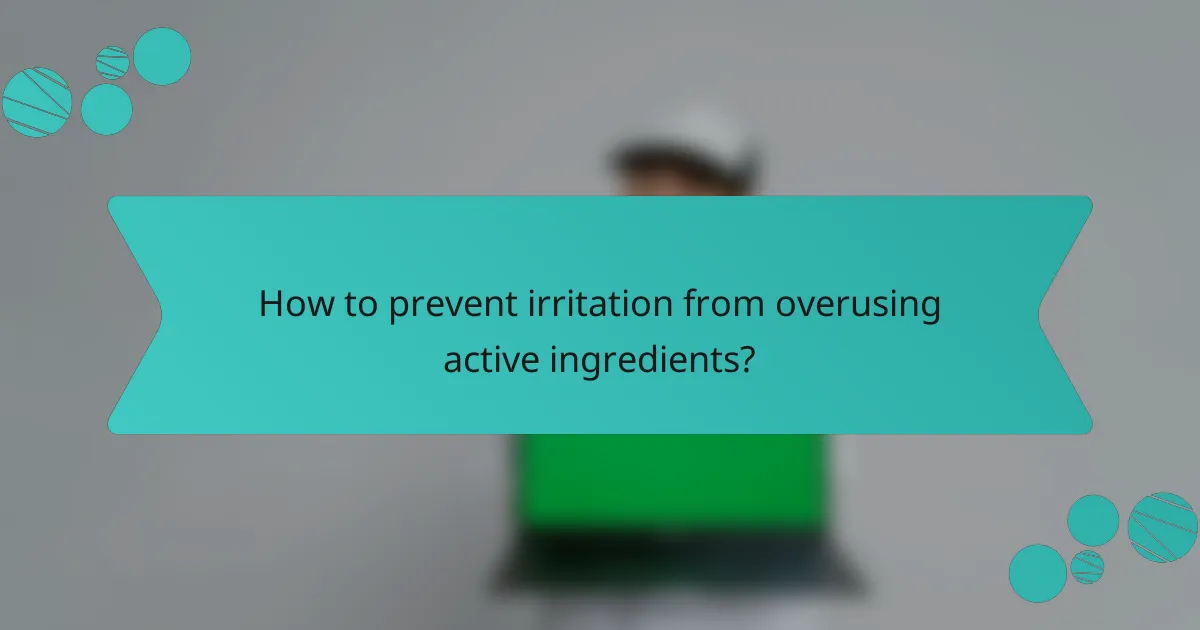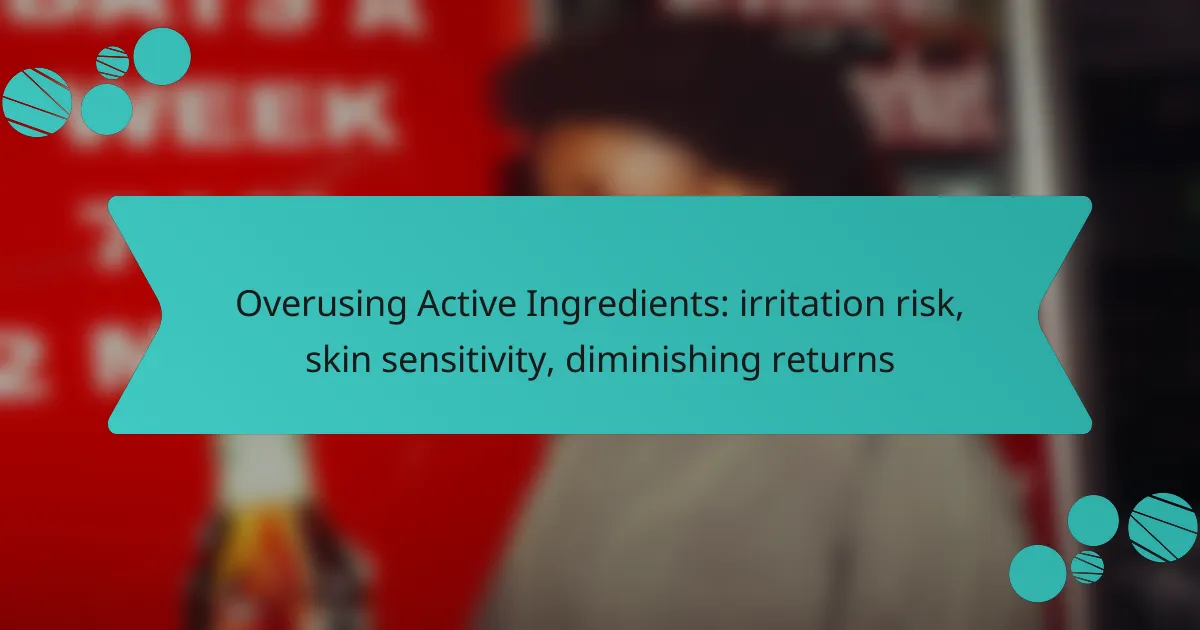Overusing active ingredients in skincare can lead to skin irritation and increased sensitivity, undermining the very benefits these ingredients are meant to provide. To avoid adverse reactions, it’s important to carefully manage the frequency and concentration of applications while incorporating soothing elements into your routine. Striking a balance is essential for maintaining skin health and achieving optimal results without compromising comfort.

How to prevent irritation from overusing active ingredients?
To prevent irritation from overusing active ingredients, it’s essential to manage application frequency, concentration levels, and incorporate soothing elements into your skincare routine. This approach helps maintain skin health while maximizing the benefits of active ingredients without causing sensitivity.
Adjust frequency of application
Reducing how often you apply active ingredients can significantly lower the risk of irritation. Instead of daily use, consider applying them every other day or a few times a week, depending on your skin’s tolerance. Monitor your skin’s response and adjust accordingly.
For example, if you’re using a retinoid, starting with once or twice a week can help your skin acclimate before increasing the frequency. This gradual approach allows your skin to adapt without overwhelming it.
Use lower concentrations
Opting for lower concentrations of active ingredients can minimize irritation while still providing benefits. Many products come in various strengths; starting with a lower concentration can help gauge your skin’s reaction.
For instance, if a product contains 1% salicylic acid, consider trying a 0.5% version first. This way, you can still achieve results without the heightened risk of sensitivity.
Incorporate soothing agents
Adding soothing agents to your skincare routine can help counteract potential irritation from active ingredients. Ingredients like aloe vera, chamomile, or niacinamide can calm the skin and reduce redness.
Look for products that combine active ingredients with soothing components, or apply a calming moisturizer after using actives to help maintain skin balance and hydration.
Consult a dermatologist
Consulting a dermatologist is crucial if you experience persistent irritation or are unsure about the right products for your skin type. A professional can provide personalized recommendations based on your skin’s needs and help you create a balanced routine.
Regular check-ins with a dermatologist can also help you adjust your regimen as your skin changes over time, ensuring you use active ingredients safely and effectively.

What are the signs of skin sensitivity?
Signs of skin sensitivity include various physical reactions that indicate irritation or an adverse response to products. Common symptoms can manifest as redness, itching, or dryness, often resulting from overusing active ingredients in skincare.
Redness and inflammation
Redness and inflammation are primary indicators of skin sensitivity. When the skin reacts to active ingredients, blood vessels may dilate, leading to a flushed appearance. This can occur after using products with high concentrations of acids or retinoids.
To manage redness, consider reducing the frequency of application or switching to gentler formulations. Look for products labeled as “hypoallergenic” or “for sensitive skin” to minimize irritation.
Itching and burning sensations
Itching and burning sensations often accompany skin sensitivity, signaling an adverse reaction to certain ingredients. These sensations can be uncomfortable and may indicate that the skin barrier is compromised.
If you experience these symptoms, discontinue use of the offending product immediately. Opt for soothing agents like aloe vera or chamomile to calm the skin and restore its barrier function.
Dryness and flakiness
Dryness and flakiness are common signs of skin sensitivity, particularly when active ingredients strip moisture from the skin. Overuse of exfoliants or strong actives can lead to a lack of hydration, resulting in visible dryness.
To combat dryness, incorporate a hydrating moisturizer into your routine and limit the use of harsh products. Look for ingredients like hyaluronic acid or glycerin, which can help retain moisture and improve skin texture.

What are the risks of using too many active ingredients?
Using too many active ingredients in skincare can lead to various risks, including skin irritation, reduced effectiveness, and potential allergic reactions. It’s crucial to balance the use of these ingredients to maintain skin health and achieve desired results.
Increased skin irritation
Overusing active ingredients can significantly increase the risk of skin irritation. Ingredients like retinoids, alpha hydroxy acids, and benzoyl peroxide can cause redness, peeling, and discomfort when applied excessively or in combination with other potent agents.
To minimize irritation, consider using a patch test before introducing new products. Start with lower concentrations and gradually increase usage to allow your skin to adapt.
Diminishing returns on effectiveness
When too many active ingredients are layered, the skin may not absorb them effectively, leading to diminishing returns. The skin can become overwhelmed, making it harder for any single ingredient to deliver its intended benefits.
To maximize effectiveness, focus on a few key ingredients that target your specific skin concerns. A simplified routine can often yield better results than a complex one.
Potential for allergic reactions
Using multiple active ingredients increases the likelihood of allergic reactions, which can manifest as rashes, swelling, or hives. Ingredients that are generally safe can become problematic when combined with others, especially for sensitive skin types.
To avoid allergic reactions, introduce new products one at a time and monitor your skin’s response. If you experience any adverse effects, discontinue use immediately and consult a dermatologist.

How to choose the right active ingredients?
Choosing the right active ingredients involves understanding your skin type and concerns, ensuring compatibility with other ingredients, and prioritizing based on your specific skin goals. This approach minimizes irritation risks and enhances the effectiveness of your skincare routine.
Identify skin type and concerns
Start by determining your skin type, which can be oily, dry, combination, or sensitive. Each type reacts differently to various active ingredients, so knowing your skin’s characteristics is crucial for effective treatment.
Next, assess your specific skin concerns, such as acne, aging, or hyperpigmentation. For example, if you have acne-prone skin, ingredients like salicylic acid or benzoyl peroxide may be beneficial, while those with dry skin might prefer hyaluronic acid or glycerin.
Research ingredient compatibility
Not all active ingredients work well together. Some combinations can lead to irritation or reduce effectiveness. For instance, using retinol alongside vitamin C can be harsh for sensitive skin.
Check compatibility charts or consult with a dermatologist to avoid common pitfalls. Ingredients like niacinamide and salicylic acid can complement each other, while others may counteract benefits.
Prioritize based on skin goals
Establish clear skin goals, such as hydration, brightening, or anti-aging. This focus will guide your ingredient selection, ensuring you choose those that align with your desired outcomes.
For example, if your goal is to reduce fine lines, prioritize ingredients like retinoids or peptides. If you aim for a brighter complexion, consider vitamin C or alpha hydroxy acids. Always start with lower concentrations to gauge your skin’s response before increasing usage.

What is the impact of overusing retinoids?
Overusing retinoids can lead to several negative effects on the skin, including irritation, increased sensitivity, and potential long-term damage. It’s crucial to use these active ingredients in moderation to avoid diminishing returns and adverse reactions.
Increased sensitivity
Excessive use of retinoids can significantly increase skin sensitivity, making it more reactive to environmental factors such as sun exposure and harsh weather. Users may experience redness, peeling, and discomfort, which can deter them from continuing treatment.
To mitigate sensitivity, consider starting with a lower concentration of retinoids and gradually increasing usage. Always apply sunscreen during the day, as retinoids can heighten the risk of sunburn.
Flare-ups of acne
Overapplication of retinoids can paradoxically lead to flare-ups of acne, especially during the initial adjustment period. This occurs as the skin undergoes rapid cell turnover, which may temporarily exacerbate breakouts before improvements are seen.
To manage this, limit retinoid use to a few times a week and monitor your skin’s response. If flare-ups persist, consult a dermatologist for tailored advice and potential adjustments to your regimen.
Long-term skin damage
Long-term overuse of retinoids can result in skin barrier damage, leading to chronic dryness and irritation. This can compromise the skin’s natural defenses, making it more susceptible to infections and other skin issues.
To prevent long-term damage, incorporate hydrating products into your skincare routine and avoid using multiple potent actives simultaneously. Regularly assess your skin’s condition and adjust your retinoid usage accordingly to maintain a healthy balance.

How does climate affect skin sensitivity?
Climate plays a significant role in skin sensitivity, with factors such as humidity and temperature directly influencing how the skin reacts to products and environmental stressors. Understanding these effects can help in managing irritation and maintaining skin health.
Humidity levels influence irritation
High humidity can lead to increased moisture on the skin, which may enhance the absorption of active ingredients in skincare products. While this can be beneficial, it also raises the risk of irritation, especially for those with sensitive skin. In contrast, low humidity can cause the skin to lose moisture, making it more susceptible to irritation from active ingredients.
To manage skin irritation related to humidity, consider adjusting your skincare routine. In humid conditions, opt for lightweight, non-comedogenic products that won’t clog pores. Conversely, in dry climates, use thicker moisturizers to help retain hydration and protect the skin barrier.
Cold weather exacerbates dryness
Cold weather typically leads to lower humidity levels, which can dry out the skin and increase sensitivity. This dryness can make the skin more reactive to active ingredients, potentially resulting in irritation or a compromised skin barrier. It’s crucial to recognize that skin may require different care during colder months.
To combat dryness in cold weather, incorporate hydrating serums and rich moisturizers into your routine. Look for products containing ingredients like hyaluronic acid or glycerin, which can help attract moisture. Additionally, consider using a humidifier indoors to maintain a more balanced humidity level, which can support skin hydration and reduce sensitivity.
